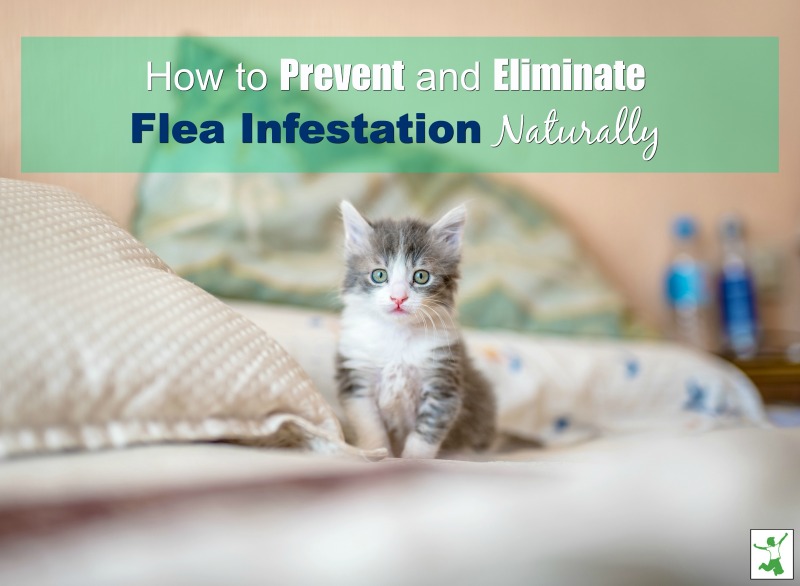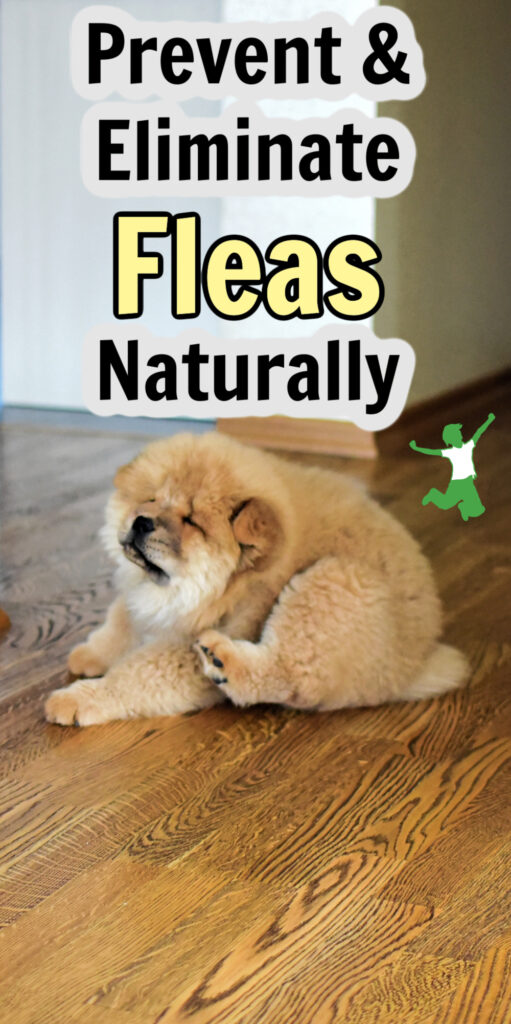Strategies to prevent and eliminate a flea infestation in your home and yard, or on your pets naturally without chemicals.

Fleas are tiny, wingless insects that survive by piercing the skin and sucking the blood of mammals and birds.
Even a single flea can wreak havoc as I discovered on a recent trip out of town when my daughter and I stayed in a home that had a large dog.
While the home itself appeared free of a flea infestation, a single flea or two must have gotten trapped under my daughter’s shirt (she liked to lay right on the dog!).
The day we got home, she discovered bites all over her torso that were a bit frightening to behold!
Fortunately, she didn’t have any other symptoms other than the visible appearance of the bites and they healed up quickly within a few days using baking soda baths and a homemade herbal salve.
Even though this experience had a happy ending, it reminded me how important it is for health-conscious families with pets living indoors to have natural, non-toxic ways to deal with a flea infestation when necessary.
It is important to know effective methods for safe flea control on your pet too instead of toxic drops, sprays, shampoos, and oral medications.
Flea Prevention is Key
Prevention is key when it comes to flea infestation problems. It is important to note that pets that are healthy are much more resistant to fleas than unhealthy pets eating highly processed bagged or canned pet food.
Assembling a raw food diet for your pet can go a long way toward preventing flea infestation problems in the first place.
Ridding Your Pet of Fleas Without Chemicals
While pets eating a nutritious diet are far less likely to attract large numbers of fleas, even animals with strong immune systems will occasionally attract a few.
Quickly running a flea comb through your pet’s fur after a walk can help keep any stray insects from making their way into the house.
Alcohol paralyzes fleas, so if you find a few while combing through your pet’s coat, drop them in a bit of alcohol to keep them from hanging around your front door to be picked up the next time your pet is outside.
According to holistic veterinarian Tamara Hebbler DVM, a good quality, natural pet shampoo (I like this one) will kill fleas just fine so there is no need to use harsh, chemical-laden formulations on a pet that has an infestation.
Simply lather up your pet and leave the suds on for about 20 minutes before rinsing off. Wrapping Rover in a towel to prevent chills during that time is a good idea too in cooler months.
Sticky Flea Traps
The most effective way I’ve found to rid your home of fleas is to use a flea trap.
This is the model I recommend. It is the best one I’ve tried for durability and effectiveness.
Place one in every room that has a flea problem. For large rooms, you may need two or three strategically placed. I’ve found one trap for every 200 square feet or so works very well.
Make sure they are on at night as this is the most active time for fleas!
Note, you can save money by using this generic brand of glue paper refills, which need to be replaced frequently if your infestation is heavy.
Once you get the problem under control, the trap only needs to be turned on one night a week or so as a “test” that everything is all clear. Be sure you are vacuuming often too.
Without a doubt, the very best vacuum for this purpose is the Dyson Animal-Pro.
I honestly do not think that without this particular vacuum and the flea traps (used as needed), that we could successfully keep two indoor/outdoor cats as we have for many years without the use of chemicals.
Keeping Fleas Away
Some of the nastiest, most toxic pet products on the market are those flea prevention drops, sprays, and shampoos.
Do you really want to douse your poor pet with pesticides and then have them lay on your carpets and furniture where your children sit and play or worse sleep in their beds?
A much better prevention strategy is to lightly dust your pet with food-grade diatomaceous earth once a week.
Diatomaceous earth is made from fossilized marine algae that have been crushed to a powder. It works by scratching the exoskeleton of fleas which dehydrates and kills them.
While non-toxic, diatomaceous earth is a respiratory irritant.
Be sure not to breathe it in and avoid your pet’s nose and eyes during application. You may wish to wear a dust mask if you are especially sensitive to airborne irritants.
I’ve used it for years without a problem and haven’t ever used a dust mask. The key is to use caution when applying as the powder is very fine and can get airborne very easily.
Warning about Essential Oils
While using essential oils around the house as a flea repellent may seem like a good idea, note that some cats are sensitive to essential oils.
Use cautiously and watch and observe your feline friends for any signs of lethargy or confusion which would indicate a reaction.
Ridding Your Home of a Flea Infestation
Suppose your house becomes a flea infestation hotbed despite all your best efforts at prevention. Rest easy knowing that there is no need to use toxic pesticides in your home to resolve the problem!
Lightly dusting the infested areas with food-grade diatomaceous earth will kill the fleas in only one day. Vacuum up the visible residue the following day and voila! no more fleas! Because diatomaceous earth is a mechanical rather than a chemical killer, it does not work on flea eggs, so you may need to reapply if a secondary wave of fleas emerges 1-4 weeks later.
The good news is that a thorough vacuum after the diatomaceous earth eliminates the adult flea problem is usually all that is required to prevent reinfestation from hatching eggs later.
Note that you can apply diatomaceous earth to upholstery and mattresses in addition to carpet if necessary.
Wool carpets and rugs should be treated as well. Use it in your car if need be.
Some sources suggest boric acid as an alternative to diatomaceous earth.
However, I don’t really like using it (a less toxic option is using borax) as it does have some mammalian toxicity even though it is low risk compared to using pesticides.
Diatomaceous earth has no toxicity at all so this option would be the best approach for eliminating a flea infestation. This is especially important if young children live in the home who are touching everything and putting their fingers and toys in their mouths.
Preventing/Eliminating Fleas in the Yard
Fleas thrive in shady areas, so only these spots in your yard are susceptible to infestation. The use of cedar or eucalyptus mulch in landscaped areas will discourage them from sticking around.
Spraying with beneficial nematodes on the grass to balance the soil will work to eliminate flea larvae as well.
I can personally vouch for the amazing effectiveness of nematode treatment for yards.
I initially sprayed nematodes on my yard several times when my husband and I first moved into our home many years ago to solve rampant problems with mole crickets.
Since then, I have never needed to use pesticides or chemicals on my lawn.
It is beautiful and lush every growing season with zero effort as the soil is balanced with plenty of beneficial microbial activity.
It is worth the effort to prevent fleas and eliminate infestations naturally both on your pet and in/around your home.
Remember that pesticides are toxic, hormone-disrupting compounds so it is best to avoid any exposure as much as humanly possible, particularly in your home where you are spending the majority of your time living, breathing and sleeping.

References
(1) Safe, Effective Flea Control
(2) Three Steps to Natural Flea Control
(3) Healing Hope, Holistic Veterinary Care
More Information
Attracting and Using Ladybugs for Garden Pest Control
Natural Fire Ant Killer that Works FAST
Assembling a Raw Food Diet for Your Pet
How to Make Nontoxic Bait to Get Rid of Ants in the House
Safely Get Rid of Carpenter Ants in a Hurry
Nontoxic Pest Control Ideas that Work
Fast and Effective Fly Repellent
Quick and Easy Homemade Fly Trap
Spider Repellent Guaranteed to Work
Fast Acting Mosquito Bite Remedy That’s Probably Already in Your Kitchen








what about lice…is there a nontoxic treatment protocol for them?
I like reading an article that can make people think. Also, many thanks for permitting me to comment!
What about Repellent Pump Spray, can it help to prevent fleas or get rid them?
Thanks for sharing some good information about pest control. Many times if the proper repellents are used on a regular basis, it is enough to keep the pest away which stops them from turning into a problem at which point they would need to be killed. Talk to your pest control company to find out the types of chemicals they use and if they are a green company.
I have used diatomaceous earth with excellent results. It’s inexpensive too.
I’m searching all over for diatomaceous earth here in the Philippines and haven’t found one. Does anyone know where can I find it here? Badly needed! Thanks
DE would kill the nematodes, NO?
Salt. Once when we had a bad infestation, I read somewhere that salt would dehydrate the adults. So I saturated my carpet with regular table salt. It took me a week to completely vacuum it all up, and I vacuumed everyday. I still had to do something differently for the animals, but the salt and vacuum took care of the house fleas.
I was all gung-ho until you recommended dusting my pet with what you describe as a respiratory irritant . Gotta do better than that!
10 Natural Wonders for Skin Diseases
http://www.healthwantcare.com/10-natural-wonders-for-skin-diseases/